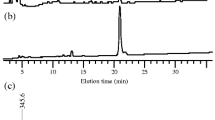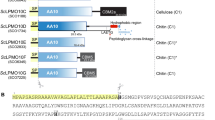Abstract
Polysaccharide lyases (PLs) are enzymes that cleave glycosidic linkages in hexuronate polysaccharides, such as homogalacturonan (HG), using a β-elimination mechanism. Traditionally, PL activities on HG have been associated with catalytic calcium cofactors, unusually high pH optima, and arginine Brønstead bases. Recently, however, PL families that harness transition metal cofactors, utilize lysine and histidine Brønstead bases, and display more neutral pH optima have been described. One such family is PL2, which has members found primarily in phytopathogenic (e.g., Dickeya spp. and Pectobacterium spp.) or enteropathogenic (e.g., Yersinia spp.) bacterial species. PL2 is divided into two major subfamilies that are correlated with either an endolytic or exolytic activity. This study has focused on the activity of a PL2 member, which is not classified within either subfamily and helps to illuminate the origin of enzyme activities within the family. In addition, the role of Mg2+ as a preferential catalytic metal for an intracellular PL2 (PaePL2) is described. The implications for the relationship between catalytic metal selectivity and the cellular location of pectate lyase-mediated catalysis are discussed.




Similar content being viewed by others
References
Caffall, K. H., & Mohnen, D. (2009). Carbohydrate Research, 344, 1879–1900.
Payasi, A., Mishra, N. N., Chaves, A. L., & Singh, R. (2009). Physiology and Molecular Biology of Plants, 15, 103–113.
Galletti, R., De Lorenzo, G., & Ferrari, S. (2009). Plant Signaling and Behavior, 4, 33–34.
Mohnen, D. (2008). Current Opinion in Plant Biology, 11, 266–277.
O’Neill, M. A., Ishii, T., Albersheim, P., & Darvill, A. G. (2004). Annual Review of Plant Biology, 55, 109–139.
Khan, M., Nakkeeran, E., & Umesh-Kumar, S. (2013). Annual Review of Food Science and Technology, 4, 21–34.
Garron, M. L., & Cygler, M. (2010). Glycobiology, 20, 1547–1573.
Lombard, V., Bernard, T., Rancurel, C., et al. (2010). The Biochemical Journal, 432, 437–444.
Abbott, D. W., & Boraston, A. B. (2008). Microbiology and Molecular Biology Reviews, 72, 301–316. table of contents.
Abbott, D. W., Gilbert, H. J., & Boraston, A. B. (2010). The Journal of Biological Chemistry, 285, 39029–39038.
Cantarel, B. L., Coutinho, P. M., Rancurel, C., et al. (2009). Nucleic Acids Research, 37, D233–D238.
Shevchik, V. E., Condemine, G., Robert-Baudouy, J., & Hugouvieux-Cotte-Pattat, N. (1999). Journal of Bacteriology, 181, 3912–3919.
Trollinger, D., Berry, S., Belser, W., & Keen, N. T. (1989). Molecular Plant–Microbe Interactions, 2, 17–25.
Hinton, J. C., Sidebotham, J. M., Gill, D. R., & Salmond, G. P. (1989). Molecular Microbiology, 3, 1785–1795.
Abbott, D. W., & Boraston, A. B. (2007). The Journal of Biological Chemistry, 282, 35328–35336.
Manulis, S., Kobayashi, D. Y., & Keen, N. T. (1988). Journal of Bacteriology, 170, 1825–1830.
Petersen, T. N., Brunak, S., von Heijne, G., & Nielsen, H. (2011). Nature Methods, 8, 785–786.
Mead, D. A., Lucas, S., Copeland, A., et al. (2012). Standards in Genomic sciences, 6, 381–400.
Rodionov, D. A., Gelfand, M. S., & Hugouvieux-Cotte-Pattat, N. (2004). Microbiology (Reading, England), 150, 3571–3590.
Boraston, A. B., & Abbott, D. W. (2012). Acta Crystallographica, Section F, Structural Biology and Crystallization Communications, 68, 129–133.
Tardy, F., Nasser, W., Robert-Baudouy, J., & Hugouvieux-Cotte-Pattat, N. (1997). Journal of Bacteriology, 179, 2503–2511.
Guillen Schlippe, Y. V., & Hedstrom, L. (2005). Archives of Biochemistry and Biophysics, 433, 266–278.
Gangola, P., & Rosen, B. P. (1987). The Journal of Biological Chemistry, 262, 12570–12574.
Harding, M. M. (2001). Acta Crystallographica, Section D, Biological Crystallography, 57, 401–411.
Kuppuraj, G., Dudev, M., & Lim, C. (2009). The Journal of Physical Chemistry B, 113, 2952–2960.
Levitsky, D. O., & Takahashi, M. (2013). Advances in Experimental Medicine and Biology, 961, 65–78.
Davies, G. J., Wilson, K. S., & Henrissat, B. (1997). The Biochemical Journal, 321(Pt 2), 557–559.
Sprockett, D. D., Piontkivska, H., & Blackwood, C. B. (2011). Gene, 479, 29–36.
Markovic, O., & Janecek, S. (2001). Protein Engineering, 14, 615–631.
Edgar, R. C. (2004). Nucleic Acids Research, 32, 1792–1797.
Abascal, F., Zardoya, R., & Posada, D. (2005). Bioinformatics (Oxford, England), 21, 2104–2105.
Stamatakis, A. (2006). Bioinformatics (Oxford, England), 22, 2688–2690.
Gasteiger, E. H. C., Gattiker, A., Duvaud, S., Wilkins, M. R., Appel, R. D. and Bairoch, A, “Protein identification and analysis tools on the ExPASy server.” In J. M. Walker (Ed.) The Proteomics Protocols Handbook. Humana, 2005, pp. 571–607
Xiao, Z., Bergeron, H., Grosse, S., et al. (2008). Applied and Environmental Microbiology, 74, 1183–1189.
Acknowledgments
This work was funded by a grant from the Agriculture and Agri-Food Canada.
Author information
Authors and Affiliations
Corresponding author
Rights and permissions
About this article
Cite this article
Abbott, D.W., Thomas, D., Pluvinage, B. et al. An Ancestral Member of the Polysaccharide Lyase Family 2 Displays Endolytic Activity and Magnesium Dependence. Appl Biochem Biotechnol 171, 1911–1923 (2013). https://doi.org/10.1007/s12010-013-0483-9
Received:
Accepted:
Published:
Issue Date:
DOI: https://doi.org/10.1007/s12010-013-0483-9




